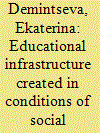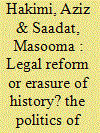|
|
|
Sort Order |
|
|
|
Items / Page
|
|
|
|
|
|
|
| Srl | Item |
| 1 |
ID:
171135


|
|
|
|
|
| Summary/Abstract |
This article demonstrates how social exclusion affects the strategies that migrants and their children experience vis-à-vis the preschool education system of the host society. We use the example of two private institutions established in Moscow by Kyrgyz migrants to explore their role in helping integrate migrant children into the host society. I examine the role the Kyrgyz community plays in the life of labour migrants in Moscow, and why private migrant infrastructure is created today by people from this particular country, though eventually migrants from other countries use it as well. I find that in recent years migrants have been creating private infrastructure in Russia as an alternative to the public one. It replaces state institutions for migrants that are not accessible to them. Migrants also view it as one of the channels for entering the Russian society and state institutions. These centres do not so much help migrants’ children escape social isolation as compensate for the lack of adjustment programmes in Russian schools.
|
|
|
|
|
|
|
|
|
|
|
|
|
|
|
|
| 2 |
ID:
171136


|
|
|
|
|
| Summary/Abstract |
This article focuses on engagement with identity documents among the rural Uzbek population in the borderlands of Kyrgyzstan. By exploring the materiality of the documents and people’s concern with these material artefacts of bureaucracy, this article illustrates how the state has been moving in, out and through the lives of the people living on the margins of the state. People’s engagement with documents illuminates the temporal dynamics of the state’s spatialization practices and highlights the fluctuating presence of the state. In addition, this article exposes the discrepancies between the classificatory bureaucratic order and the changing realities of everyday life. Gaps between these two domains are filled with what I refer to as entangled documents. People’s attempts to disentangle documents reveal how people on the margins of the state manage encounters with state bureaucracy and provide insight into the internal dynamics of a local bureaucracy.
|
|
|
|
|
|
|
|
|
|
|
|
|
|
|
|
| 3 |
ID:
171134


|
|
|
|
|
| Summary/Abstract |
This article explores the articulation and experience of Soviet gendered ideology regarding work in the Tajik SSR, one of the Muslim Soviet peripheries, during the post-war period ending with Perestroika. Central Asian women’s work was used for economic purposes, as well as being a key driver for fulfilling the ideological objective of emancipating Central Asian women from religion and tradition. Through a feminist postcolonial geography approach, attentive to questions of discourse and material lived experiences, this article explores the ways in which gender and ethnicity were co-produced by Soviet ideology. Analysis of scientific publications produced by Tajikistani female researchers, and of women’s magazines from the 1950s, is contrasted with ethnographic data on workers from various collective farms and semi-urban places, including ‘work heroines’ (peshqadam). Our findings illustrate the hybrid nature of the Soviet regime, advancing theoretical debates on the use of postcolonial theory in Soviet Central Asia.
|
|
|
|
|
|
|
|
|
|
|
|
|
|
|
|
| 4 |
ID:
171137


|
|
|
|
|
| Summary/Abstract |
ABSTRACT
In this article we reflect on our efforts to study the prosecution of moral crimes in Afghanistan. In the process of collating information about men and women imprisoned for moral crimes such as adultery, we found evidence that pointed to large-scale incarceration of men for the uncodified crime of elopement. After establishing this fact through a careful review of official data, the article considers two interrelated themes. First, we argue that government attempts to conceal its extralegal practices cannot be reduced to the question of a corrupt bureaucracy or weak governance. Rather, they reflect a fundamental tension between a modern state’s interest in projecting the rule of (codified) law and societal expectations arising from both Islamic and customary law. Second, we suggest that officials seek to address this conceptual tension between the different bodies of law through a complex process involving both accommodation and concealment. In day-to-day judicial practice, ‘assimilation’ refers to attempts to rely on sharia provisions to accommodate customary practices which have no counterpart in statutory law. ‘Dissimulation’ refers to bureaucratic actions aimed at concealing the actual practices which make such extralegal accommodations possible.
|
|
|
|
|
|
|
|
|
|
|
|
|
|
|
|
| 5 |
ID:
171133


|
|
|
|
|
| Summary/Abstract |
During the Cold War, Sharaf Rashidov became a representative of the Soviet anti-imperialist agenda, a key interlocutor with Third World leaders and a promoter of Uzbekistan as a modern and emancipated model of political, economic, social and cultural development for newly independent countries emerging from decolonization. Tashkent hosted important meetings among Soviet and Asian leaders, along with international festivals of cinema and literature, which attracted hundreds of Asian, African and Latin American intellectuals, writers, poets, journalists, trade unionists and athletes. Moreover, Uzbekistan came to symbolize the self-proclaimed compatibility between communism and Islam, offering a façade of religious freedom, tolerance and tradition combined with Bolshevik progress. The Soviet invasion of Afghanistan discredited this narrative – and Uzbekistan and (posthumously) Rashidov were humiliated in the Cotton Affair – pointing to the impact as well as the limits of Uzbek internationalism.
|
|
|
|
|
|
|
|
|
|
|
|
|
|
|
|
| 6 |
ID:
171132


|
|
|
|
|
| Summary/Abstract |
This article studies an early-twentieth-century reform in local administration on the Kazakh Steppe. It was catalyzed by the massive in-migration of peasant settlers from European Russia, which required fundamentally new administrative forms and institutional decisions from the state. In 1902 the Russian Empire extended the Temporary Regulation on Peasant Nachalniks, which was previously law only in Siberia, to the steppe oblasts of Akmola, Turgai, Semipalatinsk and Uralsk. In examining discussions surrounding the implementation of the new law, this article uncovers the complexity and ambiguities of the decisions that were made, the problems the new law faced, and the wide array of participants in enacting it. The article also compiles a socio-cultural portrait of the peasant nachalniks and the activities they undertook. Finally, it addresses how the Kazakh population perceived these new officials, and how they interacted with representatives of the Kazakh administration, which was crucial to their effectiveness.
|
|
|
|
|
|
|
|
|
|
|
|
|
|
|
|
|
|
|
|
|